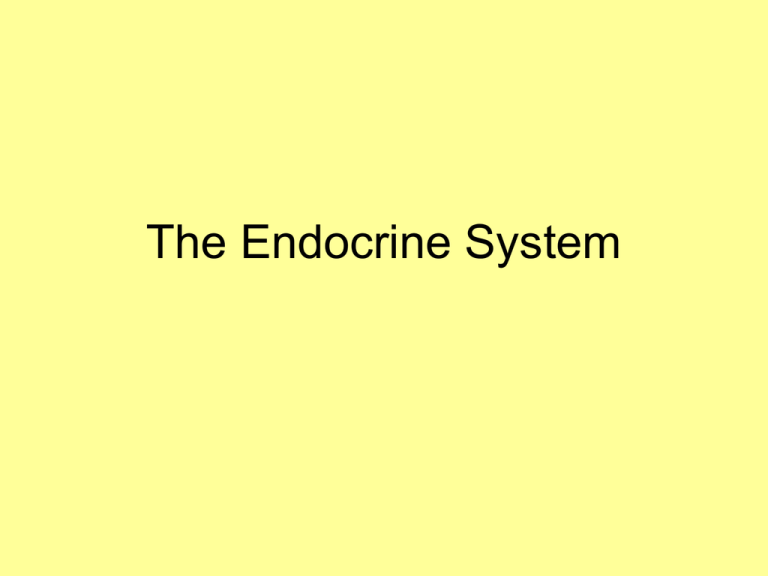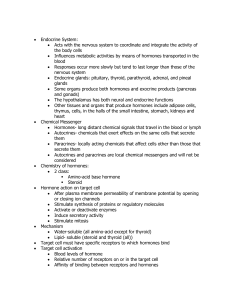Endocrine System
advertisement

The Endocrine System The Endocrine System • Chemical messages (hormones) are released into the bloodstream • Some of the major processes controlled by hormones include… – Reproduction – Growth and Development – Body Defense – Maintaining Homeostasis – Regulating Metabolism What are Hormones? • Hormones are produced by specialized cells • Cells secrete hormones into extracellular fluids (blood, lymph) • Blood transfers hormones to target sites • These hormones regulate the activity of other cells! What are Hormones? • Two major chemical classifications of hormones – Amino acid-based hormones • Examples: proteins, peptides, amines – Steroids: made from cholesterol What do Hormones cause? • • • • Synthesis of proteins, such as enzymes Activation or inactivation of enzymes Stimulation of mitosis Changes in the plasma membrane • These changes all have one common goal – to cause some larger, long-lasting change in the body! What causes Hormones to be Released? • Some sort of stimulus will trigger hormones to be released! – Hormonal Stimulus • Some hormones released will stimulate other hormones to be released What causes Hormones to be Released? – Humoral Stimulus • Changing blood levels of ions & nutrients will stimulate hormones to be released • Examples: Parathyroid hormone (PTH) will cause calcium to be released from bone into blood, ADH will cause water to be reabsorbed into blood What causes Hormones to be Released? – Neural Stimulus • Nerve fibers stimulate hormones to be released • Examples: norepinephrine and epinephrine released during stress What are some of the major endocrine organs? Endocrine Organs • Hypothalamus – Found in brain – Releases hormones that regulate the pituitary gland Endocrine Organs • Pituitary Gland – Hangs from hypothalamus, broken into two lobes – Releases hormones to control other glands – Hormones released by the two lobes include… Pituitary Gland – Posterior Lobe • Oxytocin: contraction of uterus, release of milk • Antidiuretic hormone (ADH): reabsorption of water by kidneys – Anterior Lobe • Prolactin: milk production (pro= for; lact = milk) • Follicle-Stimulating Hormone (FSH): – In females, stimulates development of follicles in the ovaries. » You will soon learn that a follicle consists of follicle cells and the developing egg – In males, FSH stimulates sperm development within the testes • Lutenizing Hormone (LH): – In females, triggers ovulation and the production of progesterone and some estrogen – In males, stimulates testosterone production and release of sperm Pituitary Gland cont • Thyroid Stimulating Hormone (TSH): stimulates thyroid gland • Growth Hormone (GH): stimulates growth, especially of bones and muscles Endocrine Organs • Gigantism – Most of the tallest people in the world are so because they have a tumor on their pituitary gland – This causes an overproduction of GH Leonid Stadnyk – 8 ft 5 in Robert Wadlow – 8 ft 11 in • Tallest man ever on record • Lived to be only 22 Endocrine Organs • Pineal Gland – Found in brain – Produces Melatonin, which helps establish day/night cycle Endocrine Organs • Thyroid Gland – Found at base of throat – Produces Thyroid Hormone, which controls the rate at which glucose is used & converted to body heat and energy Endocrine Organs • Hyperthyroidism: overactive thyroid – Produce too much thyroid hormone – Symptoms include increased heart beat, tremors, weight loss, and diarrhea • Hypothyroidism: underactive thyroid – Produce too little thyroid hormone – Can be brought on by iodine deficiency or genetics – Symptoms include poor muscle tone, fatigue, decreased heart beat, weight gain, and constipation Thyroid Gland Continued* • A second important hormone produced by the thyroid is called calcitonin – Causes calcium to be deposited into the bones *please add these notes to your packet o notes Endocrine Organs • Parathyroid – Tiny gland masses on the back of the thyroid gland – Produces Parathyroid Hormone (PTH), which controls calcium release from the bones into the blood – *PTH is a hypercalcemic hormone (increases blood levels of calcium) whereas calcitonin is a hypocalcemic hormone. Endocrine Organs • Thymus – Sits right above heart in the upper chest – Produces Thymosin, which helps mature T cells (immunity) Endocrine Organs • Adrenal Glands – Sits on top of the kidneys – Produce Aldosterone, which helps with water balance of urine/blood – Produce Glucocorticoids, which increase blood glucose levels – Produce Epinephrine/Norepinephrine, which helps with short-term stresses – Some sex hormones also made here Endocrine Organs • Pancreas – Located at curvature of duodenum just underneath the stomach – While produces enzymes that help with digestion, it also produces hormones such as… – Insulin, which increases ability of cells to transport glucose across their plasma membranes, thereby reducing glucose levels of blood Diabetes • There are generally two types of diabetes • Type 1/ Juvenile – Pancreas self-destructs, causing lack of production of insulin. • Without insulin, sugar can not be absorbed by the body – Symptoms of Type 1 diabetes (when not treated!) are • Very high blood sugar • Weight loss • 3 ‘Ps’ – Polydipsia - Excessive thirst – Polyphagia - Excessive hunger – Polyuria - Excessive urination Type 1 – Treatment of Type 1 diabetes • Diet • Daily Insulin Injections – Or -- • Insulin pump that continuously releases insulin into body. Diabetes • Type 2 / Adult Onset – Body cells become resistant to insulin • Or – Pancreas is not producing enough insulin – Symptoms of Type 2 diabetes (when not treated) are • Moderately high blood glucose levels • Polydipsia, Polyphagia & polyuria (3Ps) – When glucose flushes out of body along with water, resulting dehydration. • Because glucose is unavailable, the body will use fats and proteins for energy instead which can cause weight loss. Diabetes – Treatment of type 2 diabetes • Diet – Reduce the amount of sugar in diet and encourage weight loss • Oral medications that help – increase absorption of sugar – increase production of insulin – decrease release of internal glucose stores • Lastly, insulin injection if all above fail. Endocrine Organs • Gonads – Male: Testes • Produces Androgen hormones (especially Testosterone), which promotes male sex characteristics and helps sperm production • Stimulated to be released b/c of LH – Female: Ovaries • Produces Estrogen, which promotes female sex characteristics, stimulates growth of uterine lining • Stimulated to be released b/c of FSH • Produces Progesterone, which stimulates growth of uterine lining








